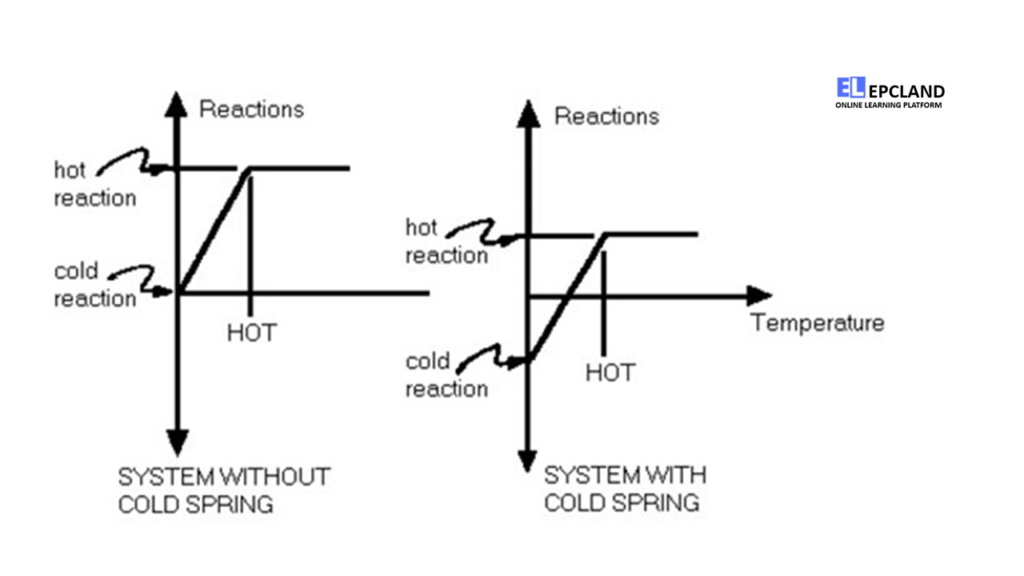Introduction
In the realm of engineering and construction, precision and durability are paramount. Cold springing, a technique often employed in various industries, plays a crucial role in achieving these goals. This comprehensive guide delves into the concept of cold springing, its applications, benefits, and techniques, shedding light on its significance in modern engineering practices.
Don’t miss the Complete Course on Piping Engineering: Check Now
By EPCLand.com
Table of Contents
Definition of Cold Spring
Cold spring refers to a deliberate engineering process involving the purposeful alteration of piping during assembly. This manipulation, often achieved by modifying the length of pipe runs between two anchor points, generates a targeted initial displacement and stress within the piping system. Cold spring is a technique employed to intentionally induce stress and elastic deformation in the piping configuration during the construction phase. This strategic approach allows the system to achieve more favorable stress distributions and reactions when operational conditions are in effect.
Exploring the Significance of Cold Spring:
Cold spring finds relevance across various engineering applications due to its capacity to yield advantageous outcomes:
1. Mitigating Creep Damage: By implementing cold spring techniques, the detrimental impact of high-temperature stresses on the material—known as creep damage—can be diminished. The intentional deformation helps to counteract the long-term effects of creep, contributing to the overall durability of the system.
2. Minimizing Reaction Forces: Cold spring also serves to decrease the reaction forces experienced by connected equipment, particularly under high-temperature conditions. This reduction in reaction forces can lead to improved operational efficiency and extended equipment lifespan.
3. Movement Space Control: Another benefit of cold springing lies in the control of movement space within the piping system. This controlled deformation ensures that potential movement and expansion are regulated, enhancing the system’s overall stability.
A system without Cold Spring Vs System with Cold Spring

Implementation of Cold Spring
The practical implementation of cold spring involves a careful consideration of various factors:
1. Addressing Expansion Stress: There is a widely held belief that the additional creep damage resulting from initial thermal expansion stress, caused by cold pull during assembly, is generally negligible. This is particularly true if the total expansion stress range falls within allowable limits. Industry codes typically do not permit the utilization of cold springs to intentionally reduce stresses.
2. Focus on Reaction Reduction: Given the constraints outlined by industry codes, the primary advantage of cold springing has shifted towards the reduction of reaction forces in connected equipment. This reduction is particularly important in scenarios where high temperatures and operational conditions could otherwise lead to excessive forces.
In conclusion, cold springing stands as a versatile engineering technique that enables intentional adjustments to piping systems during assembly. By inducing controlled deformation and stress, engineers can address issues such as creep damage, reaction forces, and movement space control. While the scope for reducing stresses using cold springs might be limited by codes, the technique remains valuable for managing reaction forces in equipment subjected to high-temperature operational conditions.
Don’t miss the Complete Course on Piping Engineering: Check Now
By EPCLand.com
Benefits of Cold Springing
Cold springing offers a range of advantages that enhance the performance and longevity of structures and mechanical systems. Some key benefits include:
1. Mitigating Mechanical Stress
Cold springing aids in reducing mechanical stress and strains that can develop during the operational lifespan of structures. By introducing intentional deformation, engineers can counteract the stresses that may accumulate due to load fluctuations and dynamic forces.
2. Minimizing Thermal Expansion Issues
Temperature variations can cause materials to expand or contract, leading to misalignments and distortions. Cold springing can offset these thermal effects, ensuring that the final assembly remains aligned and functional across different temperature ranges.
3. Enhancing Structural Integrity
Applying controlled cold springing allows engineers to achieve improved alignment and fitment of components. This precise alignment contributes to the overall structural integrity and operational efficiency of equipment and systems.
4. Reducing Operational Downtime
Cold springing mitigates the need for post-installation adjustments that can lead to downtime. By addressing potential misalignment issues during the installation process, cold springing helps expedite commissioning and reduces operational interruptions.
Techniques of Cold Springing
Several techniques are employed to achieve cold springing, each tailored to the specific requirements of the project. Some commonly used techniques include:
1. Gap Cold Springing
Gap cold springing involves introducing a controlled gap between two components during installation. As the components are brought closer, the gap is closed, inducing intentional deformation that counteracts potential stresses and misalignments.
2. Crimping Cold Springing
Crimping cold springing involves the controlled deformation of a component by applying radial pressure. This technique is commonly used in pipe fittings and connections, ensuring a secure fit and minimizing the risk of leaks.
3. Bending Cold Springing
Bending cold springing involves imparting a slight bend or curvature to a component during installation. This deformation helps accommodate potential thermal expansion and contraction while maintaining structural integrity.
4. Shim Cold Springing
Shim cold springing employs thin, wedge-shaped shims to introduce intentional misalignment between components. As the shims are removed, the components gradually settle into their desired positions, achieving optimal fitment.
Applications of Cold Springing
Cold springing finds applications in a wide array of industries, contributing to the success of various projects:
1. Piping Systems
In the field of piping, cold springing ensures that pipes maintain proper alignment and fitment, preventing leaks and enhancing the efficiency of fluid transportation.
2. Structural Engineering
Cold springing is crucial in structural projects, such as bridges and buildings, where maintaining alignment is vital for safety and longevity.
3. Power Generation
In power plants, cold springing helps maintain the alignment of turbines, generators, and associated equipment, ensuring optimal performance and minimizing wear.
4. Oil and Gas Industry
The oil and gas sector relies on cold springing to align pipelines, valves, and fittings, minimizing stress-related issues and preventing leaks in critical systems.
Cold Spring in Accordance with ASME B31.3
The application of the equations mentioned above holds validity for a two-anchor piping system devoid of intermediate restraints. However, it’s important to note that for multi-anchor piping systems and two-anchor setups with intermediate restraints, the equations (21 and 22 as stipulated in B31.3) are not deemed applicable.
In the context of varied piping configurations, a case-by-case examination becomes imperative. Each scenario necessitates a thorough analysis to determine the precise location, nature, extent of local overstrain, and its impact on stress distribution and reactions.
Considerations for Cold Spring Credit: In the domain of code adherence, the allowance to apply cold spring credit is extended to calculations involving thrusts and moments, particularly when actual reactions and their range of variations hold significance. However, it’s imperative to understand that the application of cold spring credit is restricted in the calculation of stress ranges. This limitation arises from the understanding that the range of stress variation exerts a greater influence on the piping system compared to the magnitude of stress at any given point in time.
Practical Implementation of Cold Spring: Practical implementation of cold spring requires a pragmatic approach due to inherent uncertainties. When incorporating cold spring into the piping system, experience has shown that complete assurance cannot always be achieved. Consequently, the computation of reactions necessitates a dual approach. First, by assuming that only two-thirds of the designated design cold spring is in place, and second, by assuming the presence of four-thirds of the design cold spring. This approach entails performing two separate Caesar runs—one with two-thirds cold spring and another with four-thirds. The aim is to ensure satisfactory results in both cases, particularly when employing computer analysis.
Both sustained loads and operating loads must conform to the allowable limits specified by equipment manufacturers.
Don’t miss the Complete Course on Piping Engineering: Check Now
By EPCLand.com
Cold Spring Factor (C)
The determination of the cold spring factor involves the following procedure:
- Directional Assessment: Understand the piping system and identify the direction in which the application of cold spring would yield the maximum benefit.
- Maximum Displacement: Determine the maximum displacement corresponding to the chosen direction of cold spring application. This information can be obtained from the displacement report using tools like Caesar II.
- Factor Determination: The cold spring factor is determined by the ratio of the cold spring applied to the system in relation to the overall expansion.
- Significance of Cold Spring Factor: In a fully cold-sprung system (100 percent cold spring), there would be zero loads in expansion scenarios. For instance, if a system exhibits 80mm displacement during hot conditions along the Y direction, and a cold spring of 40mm is applied, the resulting cold spring factor would be 0.5, signifying a 50% cold-sprung system.
In essence, understanding and strategically applying cold spring within the framework of ASME B31.3 guidelines allows for the optimization of stress distribution and reactions, contributing to the overall robustness of piping systems in diverse engineering contexts.
Limitations of Cold Spring Technique
The efficacy of cold springs is often met with skepticism and should not be employed indiscriminately. While they might appear to offer an expedient solution for addressing equipment load challenges, careful consideration is warranted when implementing cold spring within a piping system. The subsequent points elucidate these considerations:
- Additional Infrastructure Requirements: Incorporating cold springs necessitates the introduction of extra anchor points to maintain the cold sprung line’s position until start-up. Likewise, supplementary hoists are essential for shifting supports in the desired direction during installation. These provisions contribute to making cold springing a cost-intensive endeavor.
- Temperature Dependency: The benefits of cold springing are not as pronounced in low-temperature lines compared to high-temperature lines. The theoretical cold spring gap, which can be advantageous in low-temperature scenarios, becomes intricate to measure and control accurately within field conditions.
- Unpredictable Effectiveness: The modest displacements associated with cold spring applications render their effectiveness unpredictable. In some instances, the application might lead to an unexpectedly high load detrimental to equipment integrity.
- Misinterpretation during Operation: Upon operational phases, deliberately incorporated cold springs can be misperceived as misalignment in the piping. This misinterpretation might result in misguided “corrections” during shutdowns.
- Caution during Repairs: Caution is essential when intervening in lines with cold springs, as the lines are under stress when cold. Adequate anchoring on both sides of the cut is imperative to forestall potential accidents during repair operations.
- Varied Installation Approaches: The installation approach for each support adjacent to cold spring varies. Thorough attention is crucial during stress analysis to accurately gauge restraint displacements for achieving the desired cold spring. This meticulous care must be replicated during construction to avoid misinterpretations leading to adverse outcomes.
- Extended Impact: Often, the influence of support adjustment or displacement extends beyond a single adjacent support. This multifaceted impact necessitates understanding and acknowledgment both during the analysis and construction phases.
- Structural Collaboration: Special support drawings detailing the essential arrangements for cold springing during erection, often involving the assistance of nearby structural members, must be generated. The load impact on the respective structural components needs to be communicated to the civil team through piping load data.
- Installation Guidance: Installation instructions for cold springing should be explicitly detailed on special support drawings. Rigorous supervision of these instructions is imperative during the construction process to ensure accurate implementation.
In essence, while the cold spring technique offers potential benefits, its implementation is not without complexities. Careful planning, accurate analysis, clear communication, and meticulous supervision are imperative to ensure its successful and safe integration within the piping system.
Pros & Cons of Cold Springing
| Pros of Cold Springing | Cons of Cold Springing |
|---|---|
| 1. Stress Mitigation: Effectively reduces stress and strains in piping systems. | 1. Questionable Effectiveness: The efficacy of cold springs is often debated and not universally guaranteed. |
| 2. Alignment Enhancement: Improves alignment and fitment of components, enhancing structural integrity. | 2. Costly Implementation: Requires additional anchor points and hoists, leading to increased expenses. |
| 3. Thermal Expansion Control: Minimizes the impact of thermal expansion, preventing misalignments and distortions. | 3. Temperature Dependency: Not as beneficial in low-temperature lines compared to high-temperature lines. |
| 4. Reaction Force Reduction: Decreases reaction forces on connected equipment, improving operational efficiency and equipment lifespan. | 4. Unpredictable Outcomes: Modest displacements can lead to unpredictable effectiveness and potential equipment damage. |
| 5. Controlled Movement Space: Regulates movement and expansion within the system, enhancing stability. | 5. Misinterpretation Risk: Can be mistaken for misalignment during operational phases, leading to misguided corrections. |
| 6. Applicable in Various Industries: Finds applications in diverse industries, including piping, structural engineering, power generation, and more. | 6. Caution during Repairs: Requires careful handling during repairs due to stress in cold lines, demanding proper anchoring. |
| 7. Long-Term Durability: Contributes to the longevity and durability of structures and systems. | 7. Varied Installation Approach: Installation approach varies for each support adjacent to cold spring, demanding meticulous analysis and construction. |
| 8. Code Allowance for Some Aspects: Permitted in calculating thrusts and moments with significant reactions. | 8. Extended Impact: Influence of support adjustment can extend beyond a single adjacent support, requiring comprehensive consideration. |
| 9. Structural Collaboration: Collaboration with structural members is required for successful implementation, increasing complexity. | |
| 10. Supervision and Communication: Demands rigorous supervision and clear communication during construction to ensure accurate execution. |
Don’t miss the Complete Course on Piping Engineering: Check Now
By EPCLand.com
FAQs about Cold Springing
Q1: What is cold springing? A1: Cold springing is a controlled deformation technique used in engineering to counteract potential stresses, misalignments, and thermal expansion effects.
Q2: How does cold springing work? A2: Cold springing involves intentionally deforming components during installation to compensate for future stresses and thermal changes.
Q3: What industries use cold springing? A3: Cold springing is employed in industries such as piping, structural engineering, power generation, and oil and gas.
Q4: What are the benefits of cold springing? A4: Cold springing mitigates mechanical stress, minimizes thermal expansion issues, enhances structural integrity, and reduces operational downtime.
Q5: Which cold springing technique is used for pipe fittings? A5: Crimping cold springing is commonly used for pipe fittings, ensuring a secure fit and preventing leaks.
Conclusion
Cold springing stands as a testament to engineering’s ingenuity in addressing challenges and optimizing performance. By intentionally introducing controlled deformations, engineers can ensure alignment, minimize stress-related issues, and enhance the overall durability of structures and systems. From pipelines to power plants, the applications of cold springing are diverse and essential to achieving precision and longevity in modern engineering and construction projects.
Recommended courses (Published on EPCLand)
- Basics of Piping Engineering
- Piping Layout Engineering
- Piping Material Engineering
- Piping Stress Analysis
- Complete Course on Piping Engineering
- Material Requisitions
- Piping Material Specifications
- Valve Material Specifications
Don’t miss the published articles on following:
Related Video on Cold Springing
Attempt Quiz on Cold Springing
Question 1:
What is “cold springing” in the context of engineering?
Explanation: Cold springing refers to the unintentional movement or deformation of a structure that occurs after assembly due to temperature changes. It typically involves a reduction in stress as a result of a temperature drop.
Question 2:
What factor contributes to cold springing in assembled structures?
Explanation: Differential thermal expansion, where different materials or components expand and contract at different rates due to temperature changes, contributes to cold springing in assembled structures.
Question 3:
How can cold springing be mitigated during the design and assembly process?
Explanation: Mitigating cold springing can involve pre-stressing the structure, which means applying intentional stress to counteract the anticipated stress reduction due to cold springing. This can help maintain the desired shape and alignment.
Question 4:
What industries are particularly susceptible to the effects of cold springing?
Explanation: Industries that involve the assembly of complex structures, such as the aerospace industry, are particularly susceptible to the effects of cold springing. Precise alignment and dimensional stability are critical in such applications.
Question 5:
What is the typical response to cold springing in design and engineering?
Explanation: The typical response to cold springing is applying engineering principles and techniques to minimize or control its effects, such as pre-stressing, careful material selection, and design adjustments.



